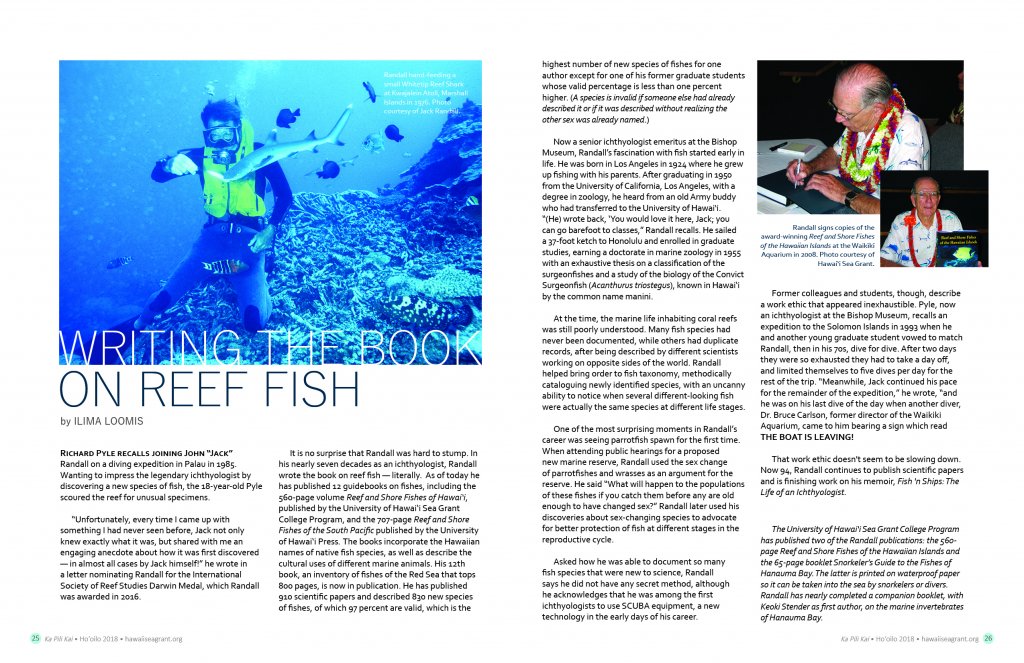Richard Pyle recalls joining John “Jack” Randall on a diving expedition in Palau in 1985. Wanting to impress the legendary ichthyologist by discovering a new species of fish, the 18-year-old Pyle scoured the reef for unusual specimens.
“Unfortunately, every time I came up with something I had never seen before, Jack not only knew exactly what it was, but shared with me an engaging anecdote about how it was first discovered — in almost all cases by Jack himself!” he wrote in a letter nominating Randall for the International Society of Reef Studies Darwin Medal, which Randall was awarded in 2016.
It is no surprise that Randall was hard to stump. In his nearly seven decades as an ichthyologist, Randall wrote the book on reef fish — literally. As of today he has published 12 guidebooks on fishes, including the 560-page volume Reef and Shore Fishes of Hawai‘i, published by the University of Hawai‘i Sea Grant College Program, and the 707-page Reef and Shore Fishes of the South Pacific published by the University of Hawai‘i Press. The books incorporate the Hawaiian names of native fish species, as well as describe the cultural uses of different marine animals. His 12th book, an inventory of fishes of the Red Sea that tops 800 pages, is now in publication. He has published 910 scientific papers and described 830 new species of fishes, of which 97 percent are valid, which is the highest number of new species of fishes for one author except for one of his former graduate students whose valid percentage is less than one percent higher. (A species is invalid if someone else had already described it or if it was described without realizing the other sex was already named.)
Now a senior ichthyologist emeritus at the Bishop Museum, Randall’s fascination with fish started early in life. He was born in Los Angeles in 1924 where he grew up fishing with his parents. After graduating in 1950 from the University of California, Los Angeles, with a degree in zoology, he heard from an old Army buddy who had transferred to the University of Hawaiʻi. “(He) wrote back, ‘You would love it here, Jack; you can go barefoot to classes,” Randall recalls. He sailed a 37-foot ketch to Honolulu and enrolled in graduate studies, earning a doctorate in marine zoology in 1955 with an exhaustive thesis on a classification of the surgeonfishes and a study of the biology of the Convict Surgeonfish (Acanthurus triostegus), known in Hawai‘i by the common name manini.
At the time, the marine life inhabiting coral reefs was still poorly understood. Many fish species had never been documented, while others had duplicate records, after being described by different scientists working on opposite sides of the world. Randall helped bring order to fish taxonomy, methodically cataloguing newly identified species, with an uncanny ability to notice when several different-looking fish were actually the same species at different life stages.
One of the most surprising moments in Randall’s career was seeing parrotfish spawn for the first time. When attending public hearings for a proposed new marine reserve, Randall used the sex change of parrotfishes and wrasses as an argument for the reserve. He said “What will happen to the populations of these fishes if you catch them before any are old enough to have changed sex?” Randall later used his discoveries about sex-changing species to advocate for better protection of fish at different stages in the reproductive cycle.
Asked how he was able to document so many fish species that were new to science, Randall says he did not have any secret method, although he acknowledges that he was among the first ichthyologists to use SCUBA equipment, a new technology in the early days of his career.
Former colleagues and students, though, describe a work ethic that appeared inexhaustible. Pyle, now an ichthyologist at the Bishop Museum, recalls an expedition to the Solomon Islands in 1993 when he and another young graduate student vowed to match Randall, then in his 70s, dive for dive. After two days they were so exhausted they had to take a day off, and limited themselves to five dives per day for the rest of the trip. “Meanwhile, Jack continued his pace for the remainder of the expedition,” he wrote, “and he was on his last dive of the day when another diver, Dr. Bruce Carlson, former director of the Waikiki Aquarium, came to him bearing a sign which read THE BOAT IS LEAVING!
That work ethic doesn’t seem to be slowing down. Now 94, Randall continues to publish scientific papers and is finishing work on his memoir, Fish ‘n Ships: The Life of an Ichthyologist.
The University of Hawai‘i Sea Grant College Program has published two of the Randall publications: the 560-page Reef and Shore Fishes of the Hawaiian Islands and the 65-page booklet Snorkeler’s Guide to the Fishes of Hanauma Bay. The latter is printed on waterproof paper so it can be taken into the sea by snorkelers or divers. Randall has nearly completed a companion booklet, with Keoki Stender as first author, on the marine invertebrates of Hanauma Bay.
Browse Ka Pili Kai issues HERE


